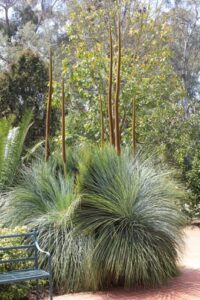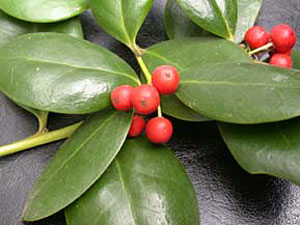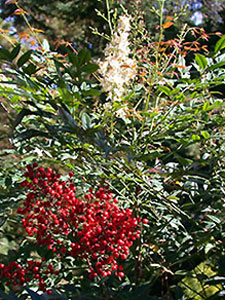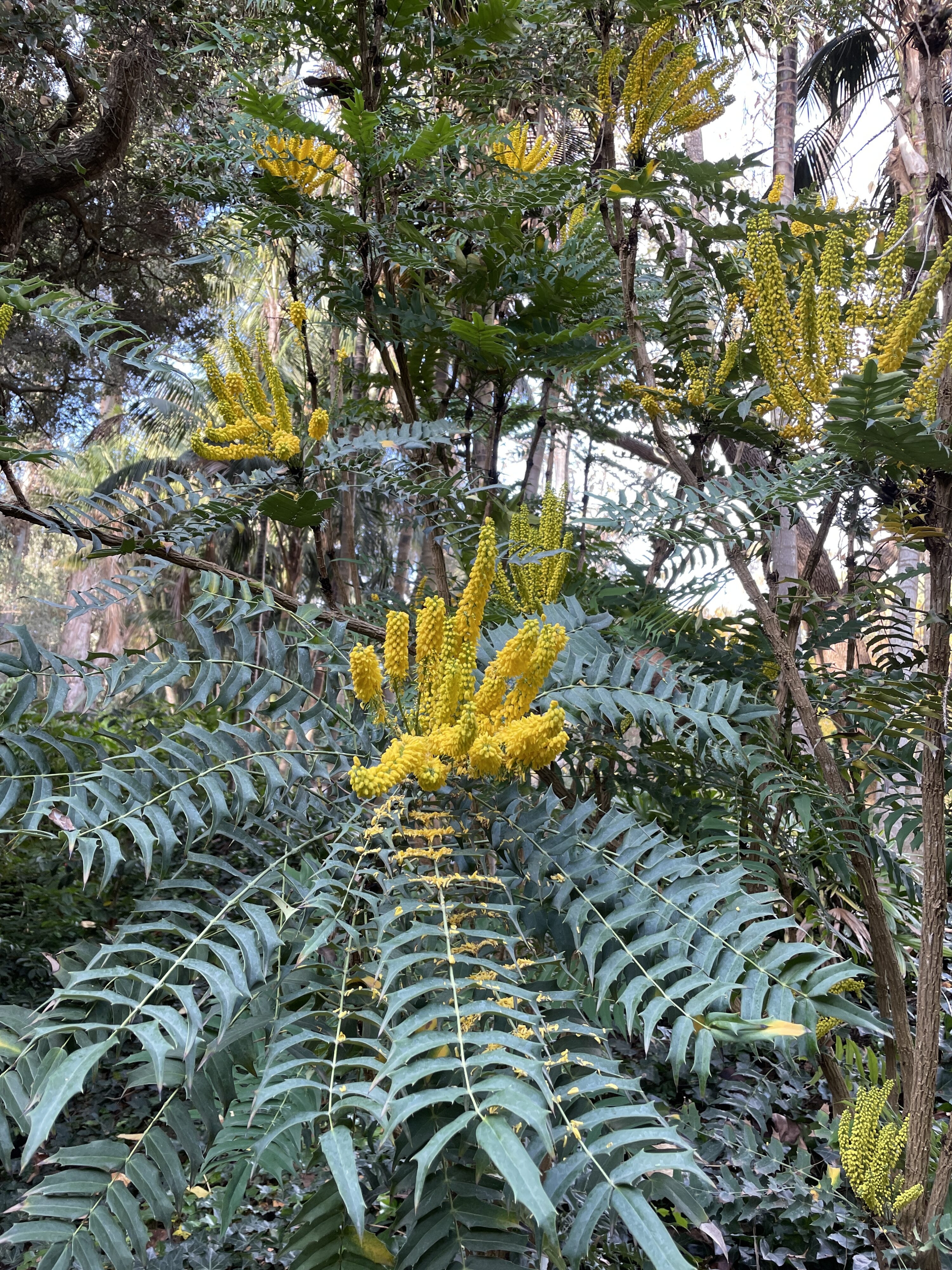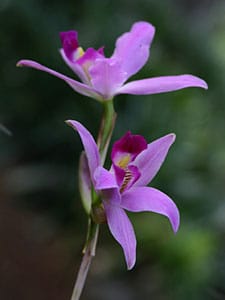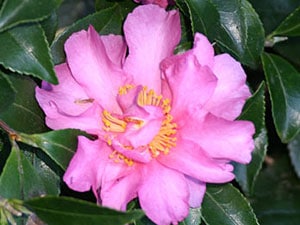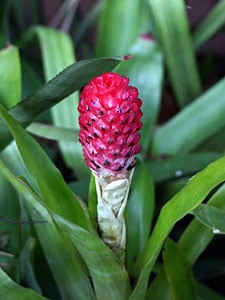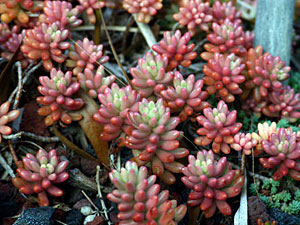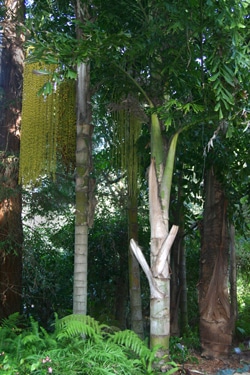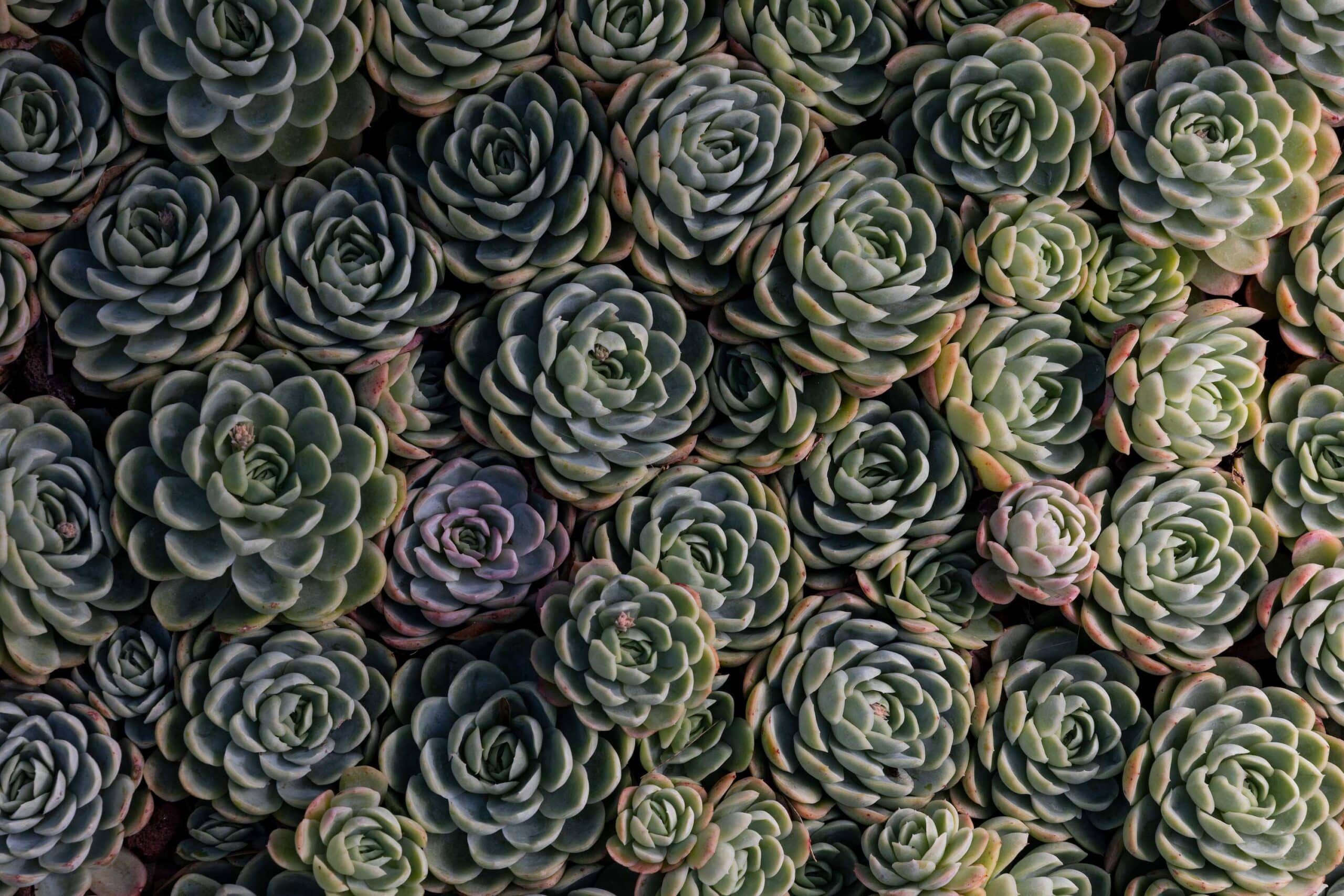
Plant Highlights
December
-
Eucalyptus megacornuta
warted yate, big-horned eucalyptus
Highlight Month:
December
Nativity:
E. megacornuta has a very limited range in the southwest of Western Australia near the Ravensthorpe Range. The population is estimated at less than 1,000 individuals and is listed as Vulnerable by the IUCN.
Growth Habit:
E. megacornuta is a great tree for small spaces, reaching only 30’ high and 15’ wide. The bark is smooth and mottled with grey, green-grey, and orange peeling strips. The leaves are evergreen, lanceolate, and contain oil glands. It is hardy to USDA Zones 9-10. This species is considered a mallet, a small form of eucalypt from Western Australia. Mallets are single stemmed, have steeply angled branches, and lack the regenerative structures of a lignotuber and epicormic buds.
Growing Requirements:
Full sun to partial shade, well-drained soils, drought tolerant once established.
Features:
This showy eucalyptus displays large chartreuse to yellow stamens over a long period from winter to summer. Flower buds are temporarily concealed by a two-inch warty cap called an operculum, resembling a monstrose fingertip. They are borne in clusters of 3-7 on a flattened woody peduncle. The flowers produce abundant nectar for pollinators and the fruits later mature into a woody capsule containing the seeds. Both the opercula and capsules can be used in dried arrangements or for art projects.
The genus name comes from the Greek, eu (well) and kalyptos (covered), referring to the operculum. The specific epithet, megacornuta, means large-horned, also referencing this same structure.
Where at Lotusland:
There is one E. megacornuta specimen at Lotusland in the Australian Garden, near the Cold Spring Gate entrance. The tree was grown from seed by Cameron Hannah-Bick, UCSB Greenhouse Manager, and donated to Lotusland in 2018.
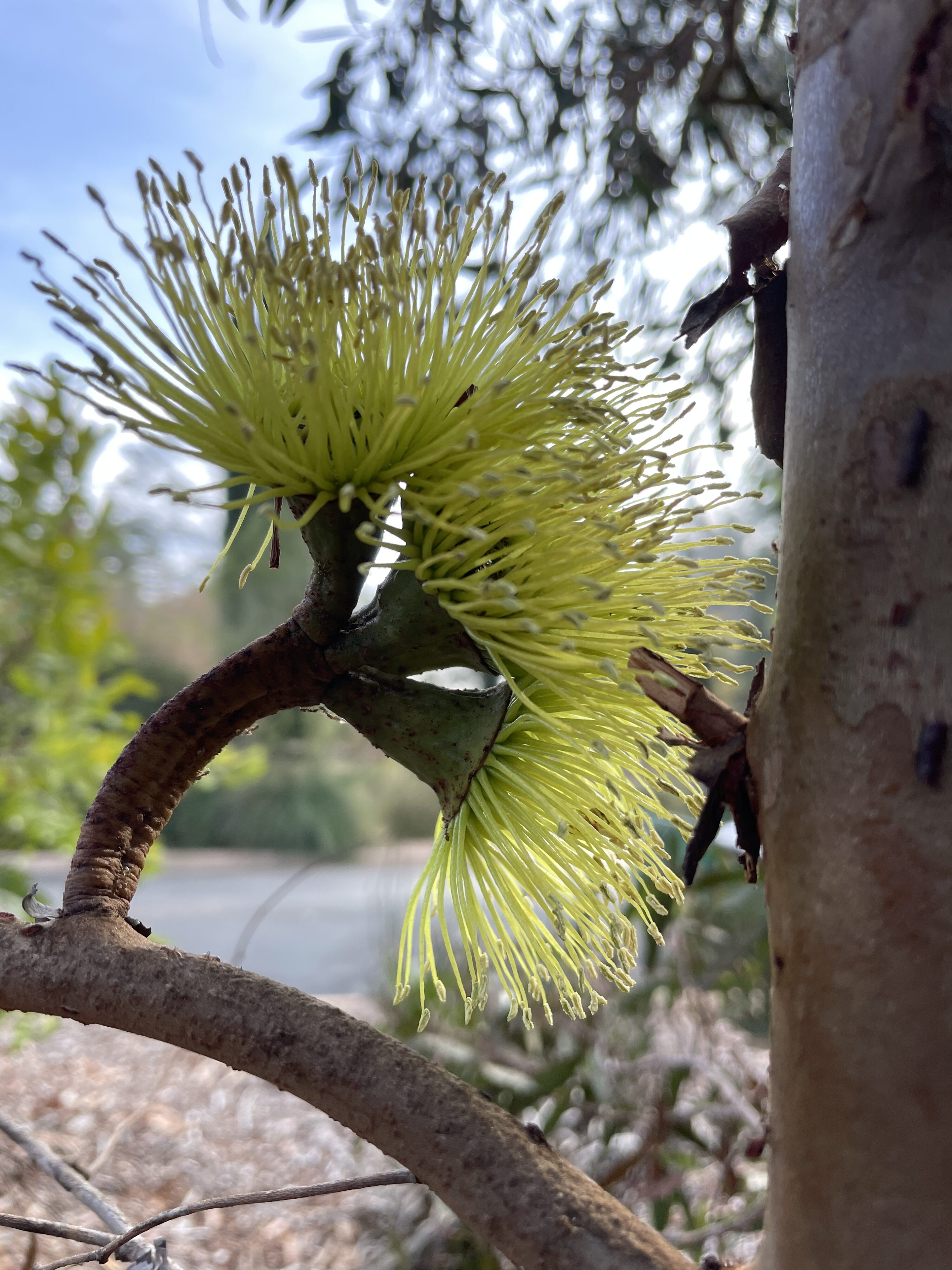
-
Xanthorrhoea quadrangulata
Australian grass tree
Highlight Month:
December
Nativity:
South Australia
Growth Habit:
Grass-like foliage covers its thick woody trunk that can reach 6’ tall. Mature plants produce a 6-12’ stalk bearing small white fragrant flowers in the spring. Slow-growing.
Growing Requirements:
Full sun, drought tolerant.
Features:
The scientific name is derived from the Greek ‘xanthos’ (yellow) and ‘rheo’ (to flow), in reference to the resin exuded out of the trunk. The resin is used by Aboriginal Australians for spear-making, patching, and as a varnish. The specific epithet comes from the Latin ‘quadra’ (four) and ‘angulata’ (angular), describing the four-sided cross section of the leaf.
Where at Lotusland:
Australian Garden near the Visitor’s Center
-
Ilex cornuta ‘Burfordii’
Burford holly
Highlight Month:
December
Nativity:
Ilex cornuta is native to East Asia; ‘Burfordii’ is a cultivar developed from a sport discovered on a plant growing in a Georgia cemetery around 1900.
Growth Habit:
A tree to 15 ft tall and 10 ft wide. It naturally forms a dense shrub, but can be pruned into a small tree by removing the lower limbs. It is easily shaped, and can even be espaliered along a wall.
Growing Requirements:
Full sun or partial shade with regular watering. It is adaptable to different soil types, and is drought-tolerant once established.
Features:
Burford holly has glossy dark green leaves with only one spine on the tip. The small white flowers are not an important ornamental feature, but are followed by clusters of large red berries in fall that last for months. Unlike some types of holly, Burford holly is self-fertile and a single plant will have prolific fruit.
Where at Lotusland:
There are two specimens growing in the Arboretum, an area between the Aloe Garden and the Japanese Garden which has many unusual trees and shrubs.
-
Nandina domestica
Heavenly Bamboo, Sacred Bamboo
Highlight Month:
December
Nativity:
China and Japan
Growth Habit:
A multi-stemmed shrub up to 8 feet tall, speading outward by underground runners.
Growing Requirements:
Nandina will grow in sun to light shade, and is adaptable to moist or dry soil. It is very hardy and resistant to oak root fungus, as well as most pests.
Features:
Although not related to bamboo, it has the same lacy, fine-textured foliage. The leaves are pinkish when young, then turn green when mature and finally bronze or red in autumn. Fall color is best in sunnier locations. Clusters of small white flowers are followed by bright red berries, though plants may have both fruit and flowers at the same time. There are many cultivars with variations of height, flower, and berry color.
Where at Lotusland:
There are over eighty Heavenly Bamboo growing in the Japanese Garden.
-
Berberis oiwakensis (syn. Mahonia lomariifolia)
Chinese holly
Highlight Month:
December
Nativity:
South-central China, Hainan, Myanmar, Taiwan, and Tibet
Growth Habit:
This architectural Berberis has it all! Long bluish-green leaves with 19-37 leaflets emerge atop corky 6-12’ stems. Fragrant bright yellow flowers appear in winter followed by edible powdery blue berries in spring, much beloved by birds. It makes a great statement in a tropical or woodland garden, even when not in bloom.
Growing Requirements:
This plant prefers moist, well-drained soils, part-shade, and is hardy down to USDA Zone 8, and possibly Zone 7 with minor damage.
Features:
There is significant debate over the correct name of this species with all Mahonia species now incorporated into the genus Berberis. The featured plant was long known as Mahonia lomariifolia, referencing the leaves appearing similar to the fern genus Lomaria (now Blechnum). B. oiwakensis is one of the parents of the B. × hortensis (Mahonia × media) hybrids, most popular being ‘Charity’ and ‘Winter Sun’.
Where at Lotusland:
Berberis oiwakensis can be found in the Japanese Garden and across the main drive in the Tropical Garden at Lotusland.
-
Laelia anceps
Highlight Month:
December
Nativity:
Mexico to Honduras
Growth Habit:
This orchid species grows epiphytically on trees. Specimens may be mounted directly on the trunk of a suitable tree or attached to a plank and hung in the garden.
Growing Requirements:
Laelia anceps should be positioned in light to moderate shade. Established plants can withstand some drought, but do best when watered regularly. Bloom production can be enhanced by monthly applications of dilute liquid fertilizer.
Features:
Laelia anceps is one of the easiest orchids for outdoor culture in Southern California. It survives temperatures as low as 22° F and does not mind hot summers.
Where at Lotusland:
There is a large hanging specimen in the Upper Bromeliad Garden.
-
Camellia sasanqua
sasanqua camellia
Highlight Month:
December
Nativity:
Japan
Growth Habit:
Evergreen shrub reaching up to 12′ tall.
Growing Requirements:
Grow these camellias in soil enriched with plenty of organic material. While they prefer a slightly acidic soil, they will tolerate more alkaline conditions. Keep uniformly moist and plant in partial shade.
Features:
Camellia sasanqua blooms earlier than other Camellia species and makes a good addition to the late-fall/winter garden. Flowers range in color from white to many shades of pink and may be single or double.
Where at Lotusland:
Lotusland’s Japanese Garden is home to several cultivars of C. sasanqua including ‘Bonanza’, ‘Jean May’, ‘Mine-no-yuki’, ‘Shôwa-no-sakae’ and ‘Shishigashira’.
-
Quesnelia testudo
Highlight Month:
December
Nativity:
Brazil
Growth Habit:
Rosettes of stiff leaves normally grow attached to tree branches, but may also grow on the ground. The leaves overlap tightly to hold rainwater in the center.
Growing Requirements:
Partial shade, consistent watering.
Features:
Leaves are coated with white hairs on the underside. Flower stalks appear in cool months and hold many dark purple tubular flowers surrounded by hot pink bracts.
Where at Lotusland:
Upper and Lower Bromeliad Gardens
-
Sedum rubrotinctum ‘Aurora’
pink jelly bean plant
Highlight Month:
December
Nativity:
Mexico
Growth Habit:
Trailing stems covered with plump jelly bean shaped leaves form a succulent groundcover.
Growing Requirements:
Full to partial sun.
Features:
This is a pastel version of the well-known jelly bean plant. Pale green shades to pink, especially when stressed from drought or cold. It is easy to propagate from stem cuttings or rooting each bean-shaped leaf.
Where at Lotusland:
Succulent Garden
-
Caryota urens
fishtail palm
Highlight Month:
December
Nativity:
SW. & S. India, Sri Lanka
Growth Habit:
This fishtail palm is solitary, meaning it forms just one trunk. It grows up to 75 feet or more. When it reaches its mature height, it begins to flower. A large, branched inflorescence is formed in succession at each leaf node starting at the apex and progressing down the trunk. The process takes many years, but when it is over, the tree dies.
Growing Requirements:
Palms require even moisture and this species thrives in shade to partial sun. Cold hardy to perhaps 22° F.
Features:
The fishtail palm is aptly named in reference to the shape of the leaflets.
Where at Lotusland:
Fern Garden, behind the Dracaena Circle


